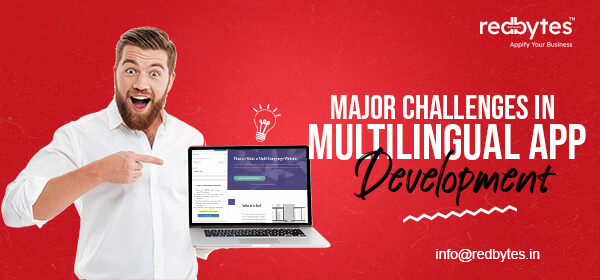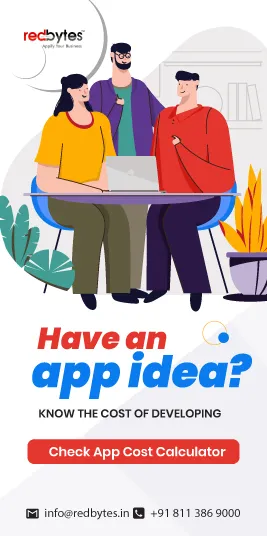As businesses are globalized and expand beyond borders, their services are becoming widely available to people living in far located lands. Due to mobile apps that allow you to reach every corner of the world, businesses today can take advantage of unrestricted access and cater to consumers efficiently. One of the factors that have played barriers in business growth is language.

English, despite being a predominant language across the globe, is not known to everyone on Earth. This means your app is unable to target the audience with little knowledge about English, limiting the brand engagement and revenues. The best way to address this situation is to develop multilingual apps. However, this optimal solution involves a handful of challenges which we are about to illuminate in the following discussion.
Let’s first take a quick glance at what defines multilingual mobile apps.
Multilingual mobile apps
Multilingual mobile apps are built to satisfy the business need to work in more than one language. Such apps focus on localization of the app content that further empowers the businesses and helps cater to target market, deliver a personalized experience, acquire more customers and expand business growth.
As multilingual mobile apps contain information in relation to local geography of users, it establishes complete integrity, trust and clarity in expectations. Businesses cover vast strata of demographics with multilingual apps and reap more from their business development strategy, eventually securing higher ROI.
Major Challenges to Multilingual apps
The reason why big brands try to scale up with apps with multilingual approach is that these apps, along with engaging more customers with content in their own language, also overcome the limitations imposed by monolingual mobile apps.
Moreover, multilingual apps are focused on different languages based on target audience, localizing the entire app content to incorporate customer requirements. But this approach is not aligned with monolingual apps, imposing major challenges for developers and brands. Here are prominent challenges to multilingual application development:
1) Direct Language Translation:
The usual approach of directly translating one language to another is not much supported when it comes to deploying fully functional and influential multilingual apps. Business apps should go beyond just translating words and need to think of altering the values, etiquette, presentation, and in some cases interface elements and much more. Here ‘much more’ is often realized as delivering a superior user experience while also making the content appear intuitive and interactive.
Moreover, language translation in multilingual apps should also be seen as tailoring the content to both technical and cultural perspective. Computer linguistics allows two methods of converting native English apps into local-language app:
- Machine translation &
- Human translation
2) Limited Capability of Machine Translation:
Machine translation has software used as a core solution to translate speech/text from one language to another. Computer engineers have experimented with various software-enabled algorithms and pre-specified rules to achieve maximum precision and perfection in language translation at optimal speed.
Though machine translation saves time, money and sounds reliable and effective compared to a human translator, the problem with software-powered translation is that they can’t deliver the same expected results as human understanding because of lack of personalization and limited capability of software intelligence.
Ideally, machines can’t provide:
- Expertise: As machine translation is predefined and formal, it can’t emphasize on the tone, flow, style, phrasing and nuance of native language. Only an excellence of human translation can influence users and make it look natural and original.
- Flexibility: Only humans can have exceptional translation skills to understand technical aspects of subject-specific texts and eliminate possible confusion.
- Creativity: Machines lack creativity and offers literal meanings of texts. Due to lack of human touch, machines fail to create the most lively, personalized or stylish expressions in native language.
- Cultural relevance: Machines lack ability to sense changing cultural trends, rituals and traditions. Hence, you can’t expect it to make apt choice of words to better convey the expression.
3) Unfeasible Human Translation:
Human translation promotes the idea of interpreting text through human experts who are versed in targeted language. Human translation mechanism produces the output content that perfectly fits the expectations of the users and creates effortless flow of information. However, the concept may seem a little unfeasible mainly because:
- Finding someone who is masterful in multiple languages is quite a challenge
- This approach also consumes great amount of time, human endeavours and cost
- Involving a professional translator boils down to paying hefty charges for translating every page even when the content is not lengthy
- Plain language translation often ensue on account of direct, seemingly robotic human translation
- This kind of solutions often miss out on exact understanding of specific nuance, metaphors and subtlety of original native language
- Systematic, formal and stiff rules of machines lower the quality of translation and impoverish the contexts or result in uncertainty of sentences
- Mismatch between conveyed meaning and absorbed information may spawn frustration in users
4) Timeframes and Geography:
This is one of the essential points to consider in multilingual application development. Because language interpretations have a lot to do with geographical boundaries and distances, developers need to ponder over several variations of the same content. The challenges in this particular event may include switching to different time zone, integrating local places and synchronizing with other cultural rituals that encircle respective target society. Eventually, what users experience in multilingual apps should be composed of local material instead of international essence.
5) Design-related Challenges:
An ideal app design swimmingly allows content to appear neat, clear and easily absorbable especially when the app is translated into different language than English. As translation and resultant text style also affect the layout of the interface, it is important to retain the original aesthetics and ensure that its look and feel still remains intuitive, engaging and easy-to-explore.

Multilingual mobile app development entails a range of changes and improvements on the original app content, one of which is its design architecture. To suit the needs of local users, it is mandatory to perform certain relevant changes to the user interface.
Solutions to alleviate Multilingual App Challenges:
1. Leave plenty of space:
It is advisable to refrain from using conventional practices of writing strings since other languages may require more space than plain English. Instead, you can prefer to employ ample space to adjust for unpredictable expansions and to avoid future errors and performance speed.
2.Make wise choices:
In Multilingual app development, it is important to choose the icons wisely to avoid any misinterpretations for people living in different regions.
3. Plan in advance:
Try not to delay mobile app localization to last minute setting before release. To achieve better product, schedule the testing and translation of the content long before the launch.
4. Testing:
Test the localization software as strictly as possible if you trust machine translation for multilingual app creation.
5. Proper usage of strings:
It is a best practice to manage your strings using Unicode/UTF-8 encoding. This approach saves extra time by saving on conversion steps, debugging and error correction.
6. Internationalization of software:
By internationalizing the multilingual software, you can make dates, numbers and figures, currencies, and other data appear in a convincing, familiar and convenient way to the users.
7. Full localization support:
The software you use for multilingual app development should better support the country code and the different variations of spelling, date formats, currencies and other elements of native countries.

Final remarks:
From the discussion, we can argue that multilingual app development might be a tough business. However, upon hitting success, the final product does drive rich benefits. By translating text and other conspicuous elements of an app, you can enhance your international reach and attract more users. App localization software not only makes your product more accessible but it also helps cross cultural and geographical boundaries to support the language of native users without changing anything about the natural flow of coding.

















